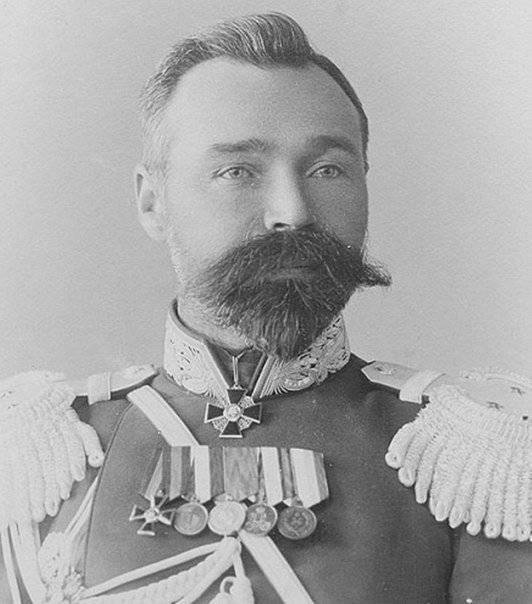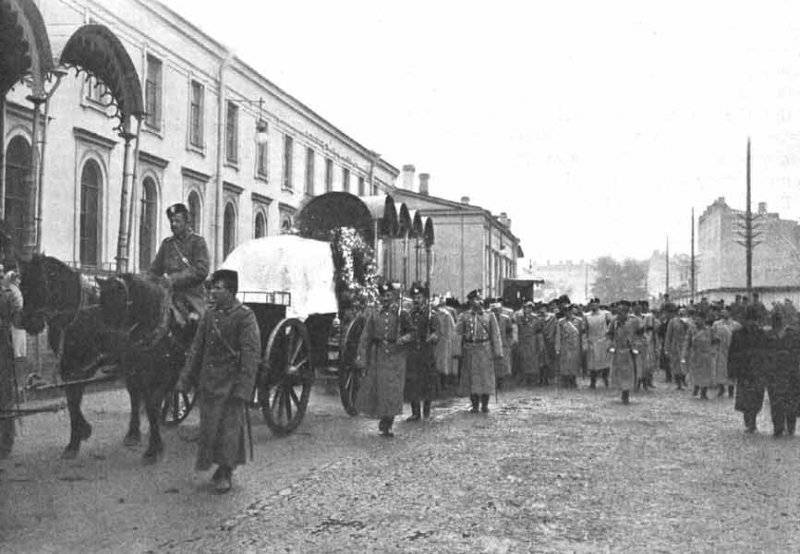Soul Defense Port Arthur

Order of the Minister of War from 20 March 1906 of the year
110 years ago, 2 (15) December 1904, died Port Isthorovich Kondratenko, a hero of Port Arthur’s defense. A direct hit of a howitzer shell in the fort number 2 claimed the life of the main mastermind of the defense of the fortress. The distinguishing feature of Major-General Kondratenko was the ability to influence the spirit of the Russian troops, to support the soldiers in the most difficult moments, which affected the reflection of several storms, when no one was already hoping for success. The general tied the land and naval forces into one, skillfully directed the Russian troops to friendly, teamwork.
The death of Kondratenko led to the rapid fall of Port Arthur. 20 December 1904 (2 January 1905) the commandant of Port Arthur, General A. M. Stoessel, and appointed after the death of Kondratenko, the chief of the land defense of the fortress, General Alexander Fock capitulated. According to many military researchers, the fortress could still be defended. Therefore, Stessel was accused of surrendering the fortress. However, Stoessel was amnestied by Emperor Nicholas II.
Soul Defense Port Fortress
“Port Arthur,” noted the military historian Kersnovsky, “gave the Russian armies and the fleet outstanding military leaders. Not to mention the protagonist of the whole war - General Kondratenko - we will only name Gorbatovsky, Irman, Schwartz, Grigorovich, Essen, Kolchak. ”
Kondratenko was one of those people who are called the “salt of the earth” in Russia. In peacetime, calm, immaculately honest and inconspicuous servant, during the fatal trials transforming into a real hero, who himself becomes a hero and leads the rest with a less strong spirit.
Roman Isidorovich was born on September 30 (October 12). 1857 was in the family of a retired major of the Tiflis garrison battalion. His father, Isidor Denisovich Kondratenko, was recruited from an ordinary peasant family from Yekaterinoslav, and earned the rank of major and noble title as an impeccable service. The family was poor, she lived on a small retirement of her father, so the last tenth child of Major Roman, with 7 years, earned her first money as a spreader of spring water in the Tiflis bazaar. After his father died suddenly, the family almost fell into poverty. However, the position was saved by the elder brother Romana Elisha, who received a good education. He was married to Yulia Vasilyevna, nee Tanner. The woman she was wealthy and took an active part in the fate of Roman.
She went with a small nephew to an elementary school course, taught Roman to German and French. Talent and high performance allowed the young Roman to easily enter the Polotsk military gymnasium and finish it brilliantly. He studied well, not only helping his comrades, but also giving lessons to those who are preparing to go to college, earning money for small needs. Equally brilliantly finishes Roman and Nicholas Engineering School in St. Petersburg. Kondratenko not only successfully managed to master the course, which was the most difficult among military schools, but also intensively engaged in self-education. In particular, he perfectly mastered the English language, which was not included in the required course.
In 1877, he was promoted to ensigns in the 1-th Caucasian Sapper Battalion, then received the rank of lieutenant. Kondratenko was not mired in the routine of the daily service of distant garrisons, did not drink, did not become a player from boredom, but intensively engaged in self-education. This allowed him to brilliantly complete two academies - the Engineering and the General Staff. For success in the sciences in the year 1881 produced in the captains. In 1882, he was transferred to the military engineers of the Caucasian Military District. Roman Isidorovich not only studied well, but was also an inventor. He compiled a project of ground fortifications of the Batumi fortress that struck many specialists and defended it in St. Petersburg in the Engineering Committee. Later, this work will help Kondratenko to create a Port Arthur land defense.
In his spare time, Kondratenko, on his own initiative, develops a statistical section of the Caucasian Reference Calendar, creates a rangefinder, and builds a model with his own money. Already commanding the company, Roman Isidorovich organized an elementary school for junior officials. He regularly lectured for commanders in the battalion and regiment on the theory and practice of military affairs. Among the personal qualities of Roman Kondratenko can be noted impeccable honesty, integrity and a heightened sense of justice. Smooth and calm, benevolent and soft in nature, Roman Isidorovich irritated those colleagues who committed flaws in their work. He stubbornly exposed the careless people, regardless of the rank and position. At the same time, contemporaries noted Kondratenko’s personal courage. In any confusion and panic, he remained calm and tried to restore order. Thus, under the heavy fire of the enemy on the mountain High, General Kondratenko rose to his full height and told the soldiers, who showed signs of cowardice: “Brothers! It is better to die than disgrace yourself and retreat. Remember, Tsar Batyushka and Russia are hoping for you. No retreat! All die, and not retreat. Well, well done, with God, go ahead! ”Until his death, Kondratenko will almost continuously be on the front line.
In 1901, Kondratenko was promoted to major general for the appointment of the head of the Amur military district as a district duty officer. In 1903, he was appointed commander of the 7 of the East-Siberian rifle brigade in Port Arthur, and soon she would be deployed to the division. With the beginning of the war in Japan became the chief of the land defense of the fortress.
Versatile knowledge allowed Kondratenko to organize the defense of the fortress in such a way that Port Arthur was able to repel the assault 4. As contemporaries noted, General Kondatenko did as much as he hadn’t done in 7 years. This allowed for a long time to forge the strongest Japanese army. The Japanese at Port Arthur lost more than 100 thousand people, in fact, put the color of the Japanese imperial army.
General Kondratenko, as a first-class tactician, the only one of all the generals of Port Arthur, and the whole Manchurian army, saw the importance of embedding the defense of a fortress on distant approaches, especially he noted the position of Jingzhou (Battle for the "Port Arthur Gate". Fight with Jinzhou; Part 2). Here, the narrow isthmus allowed, with its preliminary strengthening, to permanently detain the Japanese army. To capture the fortified area (if it were built), the Japanese army would have to spend a lot of time, resources and forces. However, Stoessel and Fock were not going to defend Jingzhou. Here, the defense held only one 5 th East Siberian Rifle Regiment. The Russian regiment stood to death, losing more than a third of its composition and more than half of the officers, but in Russian positions it was down to 10% of the Japanese army. And the main forces of the 4 th East Siberian Rifle Division, led by Major General Fock, did not take part in the battle at all. Although their entry into battle at the most decisive moment could radically change the situation. Nor did the fleet assist the Russian detachment. As a result, the “Port Arthur Gate” quickly fell. They abandoned the port of Dalny, which was built by saving on the construction of fortifications of Port Arthur. All attempts by Kondratenko to help the heroic 5 regiment were useless.
Thanks to the initiative and energy of Kondratenko, the front line of defense was already equipped during the war, which consisted of a number of temporary forts and field fortifications. Their capture cost the Japanese army tremendous effort and sacrifice. General Kondratenko proposed the brilliant idea of creating fortifications on Mount Lyaoteshany, a huge rocky hill that dominated the forts, the city and the port. During the siege, fortifications were built on the Lyaoteshansky peninsula. Kondratenko admitted the fact that the Japanese troops would break through the line of forts of the main defensive belt, and the troops would have to be led to Liaoteshan to give the enemy the last battle there and fight there until the last shell and patron. Only the premature death of Kondratenko did not allow him to carry out this plan.
In Port Arthur, Kondratenko had not only to confront an external enemy, but also to restrain the intrigues of command. In the fortress, several senior commanders turned out to be at once, who were pulling the blanket over themselves. The chief of the Kvantunskiy fortified area, General Stoessel, the commandant of the fortress, General Smirnov, the governor of the Far East, the admiral and the commander of the Russian troops in Manchuria, Alekseev, and the commander of the Pacific squadron, Rear Admiral Vitgeft constantly intrigued. In addition, they created an atmosphere of impatience and misunderstanding between sailors and representatives of the ground forces. Only Kondratenko was above intrigue. It was hard for him, in contrast to the heroes of the defense of Sevastopol, there was no team of senior commanders here, united by a single goal.
Those who could help the defense of the city went to General Kondratenko. Lieutenant Podgursky built a self-made hand grenade from a 37-mm shell shell. Kondratenko immediately appreciated the benefits of the new weapons and launched a hand grenade ("bomb") in production. By the end of the siege of the fortress, grenades were made daily to 300. Michman Vlasyev, in view of the shortage of machine guns, suggested tying up five rifles in one machine and using them as a kind of mitrale. So, initially they called a quick-firing multi-barreled artillery gun, leading volley fire with rifle-caliber cartridges, then they began to call it machine guns. Vlasyev also became the author of a new formidable weapon - a mortar, which will play a large role in future wars. Michman Sergey Vlasyev proposed to use for this purpose a mine for firing from 47-mm naval cannon. Captain Leonid Gobyato led the work on the creation of "mine mortars" and invented the mine over-caliber with a stabilizer. Saper Debigory-Mokrievich proposed to the General the idea of a lighting grenade. The sailors suggested using sea-mine devices for firing torpedoes on land and passing electric current through the barbed wire. New types of anti-personnel mines were also introduced. Behind all this was Kondratenko.
At the same time, Kondratenko, with his kind fatherly attitude toward the soldiers, sealed the garrison, created a single force. Under the influence of General Kondratenko and his closest associates - Bely, Gorbatovsky, Naumenko and other spiritual forces of Port Arthur defenders became a single steel blade that bent, but withstood the pressure of the enemy. The soldiers trusted Kondratenko selflessly. "No assault can be terrible," Roman Kondratenko, the defenders of Port Arthur, urged, "if we decided to carry out our oath to the end."
Before the defense of Port Arthur, the name Kondratenko was little known. The heroic defense of Port Arthur raised his name to great heights. Kondratenko showed that not only persistent soldiers and brave officers remained in Russia, but also talented military leaders, capable of uniting people at the most terrible time, leading them into battle. Kondratenko retained the military honor of the Russian Empire. The soldiers and officers of Port Arthur literally idolized Roman Kondratenko. When the coffin with the body of a national hero traveled from Odessa to St. Petersburg for more than a week, literally the whole country met him.
Funeral Kondratenko. 25 September 1905

Information